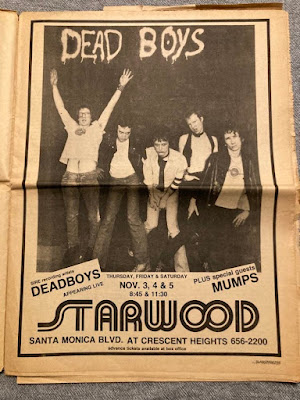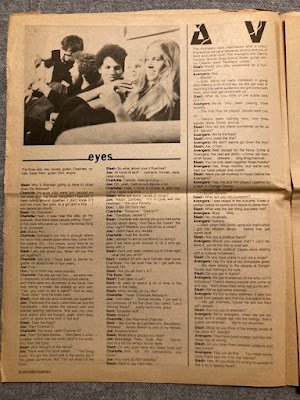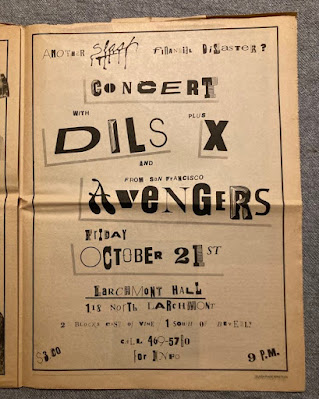SLASH MAGAZINE, Volume 1 Number 5
I believe this is Slash mag's issue from October of 1977, when things were really starting to heat up in LA. It's also the only issue of Slash magazine which I have ever owned. I'm not 100% sure of how it came into my possession, but I believe it was a number of years ago via one Richard Stanley. Slash has now been anthologised or you can read complete PDFs on the internet, but for many years it was simply a known entity, its striking images drilled into your mind over decades of having seen snippets here and there in other publications, but rarely, unless you were one of the lucky ones to actually own individual issues, something one could grasp. Imagined but rarely seen.
This might not be the case in the US - there were 10,000 copies of this issue printed - but I imagine few ever made their way down to Australia, and probably few of those 10,000 copies have remained intact in the intervening 45 years. This issue is also so delicate, its newsprint paper crumbling ever-so-slightly by the sands of time every day, that I almost feel nervous even picking it up, feeling that it might disintegrate in my hands if I mishandle it. Look, if you're coming over to my place for a perusal, it's strictly white gloves and tweezers, OK?
The story of Slash is well known. Founded by Steve Samiof and Melanie Nissen, it was thee publication which put LA punk on the map. Flipside may have lasted longer and ultimately been more successful in some metric (and I certainly enjoyed Flipside for many, many years), but Slash was the attitude of early LA punk, and at centre stage was French emigre, Claude Bessy, AKA Kickboy Face, the heart and soul of it all.
Much has been written about the transition of LA punk from the more arty, bohemian early days of 1977 - 1979 when it was all about the Masque, Dangerhouse, the Canterbury apartments, etc. to the suburban/South Bay invasion of 1979/'80 when many of the original inhabitants bailed or turned to other musical pursuits while the slammin' baldies took over. Slash, stating the obvious, encapsulates the former.
Reading it, in particular this issue, is no disappointment. The lineup in here is first-rate and like a roll-call for what was happening right there and then with the finest sounds of the city (and not forgetting a little San Fran): The Weirdos, Avengers, Eyes, Skulls, Bags, Alleycats - and, on a bigger scale, though still quite underground then - Devo and cover star Debbie Harry of Blondie (and you can dismiss them as New Wavers as much as you want, but Debbie Harry and her partner in crime, Chris Stein, have always come across as some of the coolest and most genuine people in rock music, both then and now).
Kickboy gives a typically slam-dunk editorial - LAYING IT ON THE LINE, BROTHERS AND SISTERS - and this is what gave Slash its moral fire. You mighta dismissed Claude, Steve, Filomena et al as a bunch of 30-something art-burnout cokeheads (and by golly, you'd be wrong), but they were on a mission to spread the word in what must have seemed like a cultural wasteland beyond repair, much worse than the UK, which at least made punk a chart-topping phenomenon. Not that this situation bothered those involved.
Bessy noted to Jon Savage in England's Dreaming: "The disaffection was enormous, there were a lot more closet art weirdos out there. They had this incredible sense of humour, they were really proud of looking like shit on the streets... The media totally ignored it: the record companies and the media were all hippies who had made it, and they were very hostile. That's when it got good, actually. We decided that it was our party, nobody was interested, so let's go wild. It definitely seemed like we were going to be rejects forever".
Jon Savage: For English people dazed by the Los Angeles sun, it is difficult to realise that this fantasy city can harbour oppression all the more cruel because it is masked by image and wealth.
When I was much younger, I found it fascinating that these older people - hell, OLD people in their 30s! - had jumped head-first into the world of punk rock in LA at its very inception, seeing a gap, an opportunity, to make trouble and have some fun. Perhaps Samiof was slightly more monetarily motivated, though for Claude and Filomena, it must have seemed like a second life, even though Claude also had a third successful life at Rough Trade in the UK in the '80s. And then you get 20 years older than they were and realise that some people are going to live like that their whole lives, and that's a good thing.
I think Slash would get even better than this issue as it went along and more records were being released, with more writers coming on board, but in this statement from late 1977, words leap from the page, ads for debut records by the Germs and Weirdos stand as signposts of the twisted genius this scene would foment, and it reads like a scream from the void that was eventually heard. Amazing stuff. I'll probably be buried with it.















Comments